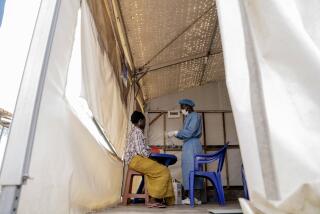Amid severe outbreak, is it time for a whooping cough booster?
- Share via
With the nation’s attention focused on dire news about whooping cough, parents’ inclination may be to hustle their children -- or themselves -- in for a booster shot.
Will there be a run on the whooping cough vaccine?
If there is, doctors should be able to handle the demand. The supply of whooping cough -- or pertussis -- vaccines is fine, according to a spokesman with the federal Centers for Disease Control and Prevention in Atlanta.
“The CDC is not aware of any supply issues as far as vaccines that protect against pertussis,” said Thomas Skinner in an email to the Los Angeles Times on Friday morning.
For a parent with a child sick with whooping cough, it can be a terrifying ordeal.
Whooping cough is an extremely contagious bacterial disease characterized by a “whooping” noise as the patient gasps for breath.
The coughing fits can lead to vomiting or even short losses of consciousness, according to the National Library of Medicine. Infants can have spells of choking with whooping cough.
Many parents are meticulous about getting their children to the doctor for the multiple shots -- five -- needed to protect against the disease. The first shot is at 2 months and the last one when the child is 4 to 6 years old.
But the vaccine wears off. As the Associated Press reported, a booster is recommended at about age 11, and health officials have debated moving it up earlier.
Now officials are saying the number of reported cases of whooping cough is nearly twice what it was at this time last year.
With 18,000 cases in 2012 so far, the final number is expected to be the highest since 1959.
The number of deaths in 2012, however, doesn’t seem to be skyrocketing. There are nine so far this year, according to the CDC. Last year there were 14, but in 2010 there were 27.
“The vast majority of deaths each year occur among children less than 1 year,” Skinner said. “However, there are typically one to three deaths ... that occur in senior adults, usually over the age of 65.”
Only infant deaths have been reported in 2012. As infants are the most vulnerable to the disease, it’s recommended that any adult who is around an infant get a pertussis vaccine.
The death rate today from pertussis is a far cry from the 1920s, when, according to the CDC, about 6,000 children died each year from the disease -- more than from diphtheria, scarlet fever and measles combined.
The vaccine was developed in the 1930s and came into wider use in the ‘40s. The number of reported cases took a dive from 156,517 in 1947 to 74,715 in 1948.
The lowest number of reported cases, according to the CDC, was 1,010 in 1976. But in 2003 -- after decades in which reported cases numbered in the thousands -- cases shot up into the tens of thousands, where they have remained.
The rise in reported cases may be due in part to better tests and increased awareness. But it’s clear this year that more 13- and 14-year-olds are contracting the disease.
The CDC’s Skinner confirmed that the agency is investigating whether the rise in the illness among young teens is due to a change in the vaccine that occurred in 1997. That year the vaccine used to immunize children was altered because the U.S. took a version of the vaccine off the market due to possible neurological side effects.
But Dr. Anne Schuchat, director of CDC’s National Center for Immunization and Respiratory Diseases, noted to The Times recently that studies attempting to confirm that link “have not been consistent.”
Schuchat said the drop in protection from the current vaccine is likely to blame for the increase. The vaccine produces 95% protection within two years. But recent studies in California show protection dropping to 70% within five years.
“That may be why we are seeing this increase,” she said.
ALSO:
Missing Iowa cousins: One set of parents hires attorney
Abduction arrest: Girl says baby brother’s screams saved her
Tennessee Muslims get new mosque, but not in time for Ramadan
Join Amy Hubbard on Google+
More to Read
Sign up for Essential California
The most important California stories and recommendations in your inbox every morning.
You may occasionally receive promotional content from the Los Angeles Times.











